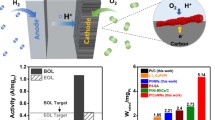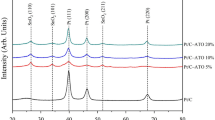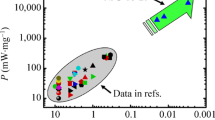Abstract
In this study, we developed a Ni/Pt bilayer catalytic anode that has high electrochemical activity and significantly reduced Pt loading amount, for low-temperature solid oxide fuel cells (LT-SOFCs). The Ni/Pt bilayer anodes with various thicknesses of the Pt catalytic active layer were fabricated on yttria-stabilized zirconia substrates via the direct current sputtering technique, and their performances were evaluated for the LT-SOFCs. The optimal thickness of the Pt catalytic layer for the Ni/Pt bilayer was found to be 10 nm based on the results for the fuel cell performance and electrochemical impedance spectroscopy (EIS) analysis. The optimal Pt10/Ni140 anode showed a cell performance and polarization resistance very similar to those of a reference single-phase Pt anode, while having only 7% of the Pt loading amount of the reference Pt anode. For the detailed morphological analysis of the bilayer structure anode, we employed the pull-off delamination process to analyze both the surface and interface morphologies of the bilayer anodes and the interface morphology of the Ni/Pt bilayer anodes after the operating test was analyzed. The results presented herein indicate the suitability of the methodology for the morphological analysis of thin-film bilayer structures and contribute to reduce the cost of membrane electrode assembly fabrication for LT-SOFCs, thus facilitating the commercialization of these systems.






Similar content being viewed by others
References
Steele, B. C. H., & Heinzel, A. (2001). Materials for fuel-cell technologies. Nature,414(6861), 345–352.
Liu, Q. L., Khor, K. A., & Chan, S. H. (2006). High-performance low-temperature solid oxide fuel cell with novel BSCF cathode. Journal of Power Sources,161(1), 123–128.
Xia, C., Chen, F., & Liu, M. (2001). Reduced-temperature solid oxide fuel cells fabricated by screen printing. Electrochemical and Solid-State Letters,4(5), A52–A54.
Xia, C., & Liu, M. (2002). Novel cathodes for low-temperature solid oxide fuel cells. Advanced Materials,14(7), 521–523.
Song, C. (2002). Fuel processing for low-temperature and high-temperature fuel cells: Challenges, and opportunities for sustainable development in the 21st century. Catalysis Today,77(1–2), 17–49.
Paek, J. Y., Chang, I., Lee, M. H., Ji, S., & Cha, S. W. (2013). Influence of target to substrate distance on properties of Y-doped BaZrO3 thin films grown by pulsed laser deposition. International Journal of Precision Engineering and Manufacturing,14(7), 839–843.
Kosacki, I., Rouleau, C. M., Becher, P. F., Bentley, J., & Lowndes, D. H. (2005). Nanoscale effects on the ionic conductivity in highly textured YSZ thin films. Solid State Ionics,176(13–14), 1319–1326.
Tuller, H. L. (2000). Ionic conduction in nanocrystalline materials. Solid State Ionics,131(1–2), 143–157.
Hui, S., et al. (2007). A brief review of the ionic conductivity enhancement for selected oxide electrolytes. Journal of Power Sources,172(2), 493–502.
Van Herle, J., McEvoy, A. J., & Thampi, K. R. (1996). A study on the La1−xSrxMnO3 oxygen cathode. Electrochimica Acta,41(9), 1447–1454.
Steele, B. C. H. (1996). Proceedings of the 10th international conference on solid state ionics survey of materials selection for ceramic fuel cells II. Cathodes and anodes. Solid State Ionics,86, 1223–1234.
Son, J.-W., & Song, H.-S. (2014). Influence of current collector and cathode area discrepancy on performace evaluation of solid oxide fuel cell with thin-film-processed cathode. International Journal of Precision Engineering and Manufacturing-Green Technology,1(4), 313–316.
Lee, Y. H., Chang, I., Cho, G. Y., Park, J., Yu, W., Tanveer, W. H., et al. (2018). Thin film solid oxide fuel cells operating below 600 °C: A review. International Journal of Precision Engineering and Manufacturing-Green Technology,5(3), 441–453.
Tanveer, W. H., Ji, S., Yu, W., & Cha, S. W. (2015). Characterization of atomic layer deposited and sputtered yttria-stabilized-zirconia thin films for low-temperature solid oxide fuel cells. International Journal of Precision Engineering and Manufacturing,16(10), 2229–2234.
Will, J., Mitterdorfer, A., Kleinlogel, C., Perednis, D., & Gauckler, L. J. (2000). Fabrication of thin electrolytes for second-generation solid oxide fuel cells. Solid State Ionics,131(1–2), 79–96.
Beckel, D., et al. (2007). Thin films for micro solid oxide fuel cells. Journal of Power Sources,173(1), 325–345.
Huang, H., Nakamura, M., Su, P., Fasching, R., Saito, Y., & Prinz, F. B. (2007). High-performance ultrathin solid oxide fuel cells for low-temperature operation. Journal of the Electrochemical Society,154(1), B20–B24.
Su, P.-C., Chao, C.-C., Shim, J. H., Fasching, R., & Prinz, F. B. (2008). Solid oxide fuel cell with corrugated thin film electrolyte. Nano Letters,8(8), 2289–2292.
Shim, J. H., Chao, C.-C., Huang, H., & Prinz, F. B. (2007). Atomic layer deposition of yttria-stabilized zirconia for solid oxide fuel cells. Chemistry of Materials,19(15), 3850–3854.
An, J., Kim, Y.-B., Park, J., Gür, T. M., & Prinz, F. B. (2013). Three-dimensional nanostructured bilayer solid oxide fuel cell with 1.3 W/cm2 at 450 °C. Nano Letters,13(9), 4551–4555.
Ji, S., Ha, J., Park, T., Kim, Y., Koo, B., Kim, Y. B., et al. (2016). Substrate-dependent growth of nanothin film solid oxide fuel cells toward cost-effective nanostructuring. International Journal of Precision Engineering and Manufacturing-Green Technology,3(1), 35–39.
Dusastre, V., & Kilner, J. A. (1999). Optimisation of composite cathodes for intermediate temperature SOFC applications. Solid State Ionics,126(1), 163–174.
Wonjong, Y., et al. (2016). PEALD YSZ-based bilayer electrolyte for thin film-solid oxide fuel cells. Nanotechnology,27(41), 415402.
Lee, Y. H., Cho, G. Y., Chang, I., Ji, S., Kim, Y. B., & Cha, S. W. (2016). Platinum-based nanocomposite electrodes for low-temperature solid oxide fuel cells with extended lifetime. Journal of Power Sources,307(Supplement C), 289–296.
An, J., Kim, Y.-B., & Prinz, F. B. (2013). Ultra-thin platinum catalytic electrodes fabricated by atomic layer deposition. Physical Chemistry Chemical Physics,15(20), 7520–7525.
Zhang, J.-M., Ma, F., & Xu, K.-W. (2004). Calculation of the surface energy of FCC metals with modified embedded-atom method. Applied Surface Science,229(1), 34–42.
Jung, H., Bae, K., Jang, D. Y., Lee, Y. H., Cha, S.-W., & Shim, J. H. (2014). Evaluation of porous platinum, nickel, and lanthanum strontium cobaltite as electrode materials for low-temperature solid oxide fuel cells. International Journal of Hydrogen Energy,39(31), 17828–17835.
Evans, A., Bieberle-Hütter, A., Rupp, J. L., & Gauckler, L. J. (2009). Review on microfabricated micro-solid oxide fuel cell membranes. Journal of Power Sources,194(1), 119–129.
Kitchin, J. R., Khan, N. A., Barteau, M. A., Chen, J. G., Yakshinskiy, B., & Madey, T. E. (2003). Elucidation of the active surface and origin of the weak metal–hydrogen bond on Ni/Pt(111) bimetallic surfaces: A surface science and density functional theory study. Surface Science,544(2), 295–308.
Ramaswamy, V., Phillips, M. A., Nix, W. D., & Clemens, B. M. (2001). Observation of the strengthening of Pt layers in Ni/Pt and Pd/Pt multilayers by in situ substrate curvature measurement. Materials Science and Engineering A,319–321(Supplement C), 887–892.
Xiong, L., & Manthiram, A. (2005). Effect of atomic ordering on the catalytic activity of carbon supported PtM (M = Fe Co, Ni, and Cu) alloys for oxygen reduction in PEMFCs. Journal of the Electrochemical Society,152(4), A697–A703.
Shi, G., Yano, H., Tryk, D. A., Iiyama, A., & Uchida, H. (2017). Highly active, CO-tolerant, and robust hydrogen anode catalysts: Pt–M (M = Fe Co, Ni) alloys with stabilized pt-skin layers. ACS Catalysis,7(1), 267–274.
Bae, J., Yang, H., Son, J., Koo, B., & Kim, Y.-B. (2016). Enhanced oxygen reduction reaction in nanocrystalline surface of samaria-doped ceria via randomly distributed dopants. Journal of the American Ceramic Society,99(12), 4050–4056.
Steinbach, A. (2017). High performance, durable, low cost membrane electrode assemblies for transportation applications. Maplewood: 3M Company.
Seo, H. G., Choi, Y., Koo, B., Jang, A., & Jung, W. (2016). Robust nano-architectured composite thin films for a low-temperature solid oxide fuel cell cathode. Journal of Materials Chemistry A,4(24), 9394–9402.
Holton, O. T., & Stevenson, J. W. (2013). The role of platinum in proton exchange membrane fuel cells. Platinum Metals Review,57(4), 259–271.
O’Hayre, R., Lee, S.-J., Cha, S.-W., & Prinz, F. B. (2002). A sharp peak in the performance of sputtered platinum fuel cells at ultra-low platinum loading. Journal of Power Sources,109(2), 483–493.
O’hayre, R., Cha, S.-W., Prinz, F. B., & Colella, W. (2016). Fuel cell fundamentals. New York: Wiley.
Barsoukov, E., & Macdonald, J. R. (2005). Impedance spectroscopy: Theory, experiment, and applications. New York: Wiley.
Jiang, S. P., & Badwal, S. P. S. (1999). An electrode kinetics study of H2 oxidation on Ni/Y2O3–ZrO2 cermet electrode of the solid oxide fuel cell. Solid State Ionics,123(1), 209–224.
Jiang, S. P., & Badwal, S. P. S. (1997). Hydrogen oxidation at the nickel and platinum electrodes on yttria-tetragonal zirconia electrolyte. Journal of the Electrochemical Society,144(11), 3777–3784.
Fu, Q. X., Tietz, F., & Stöver, D. (2006). La0.4Sr0.6Ti1−xMnxO3−δ perovskites as anode materials for solid oxide fuel cells. Journal of the Electrochemical Society,153(4), D74–D83.
Primdahl, S., & Mogensen, M. (1997). Oxidation of hydrogen on Ni/yttria-stabilized zirconia cermet anodes. Journal of the Electrochemical Society,144(10), 3409–3419.
Yu, C.-C., Kim, S., Baek, J. D., Li, Y., Su, P.-C., & Kim, T.-S. (2015). Direct observation of nanoscale Pt electrode agglomeration at the triple phase boundary. ACS Applied Materials and Interfaces,7(11), 6036–6040.
Acknowledgements
Y. B. K gratefully acknowledges financial support from the Korea Institute of Energy Technology Evaluation and Planning (KETEP) and the Ministry of Trade, Industry and Energy (MOTIE) of the Republic of Korea (no. 201700000003242) and Basic Science Research Program through the National Research Foundation of Korea (NRF) funded by the Ministry of Education (2012R1A6A1029029).
Author information
Authors and Affiliations
Corresponding author
Additional information
Publisher's Note
Springer Nature remains neutral with regard to jurisdictional claims in published maps and institutional affiliations.
Rights and permissions
About this article
Cite this article
Lim, Y., Hong, S., Jang, KL. et al. High-Performance Ni/Pt Composite Catalytic Anode with Ultra-Low Pt Loading for Low-Temperature Solid Oxide Fuel Cells. Int. J. of Precis. Eng. and Manuf.-Green Tech. 7, 141–150 (2020). https://doi.org/10.1007/s40684-019-00121-5
Received:
Revised:
Accepted:
Published:
Issue Date:
DOI: https://doi.org/10.1007/s40684-019-00121-5




